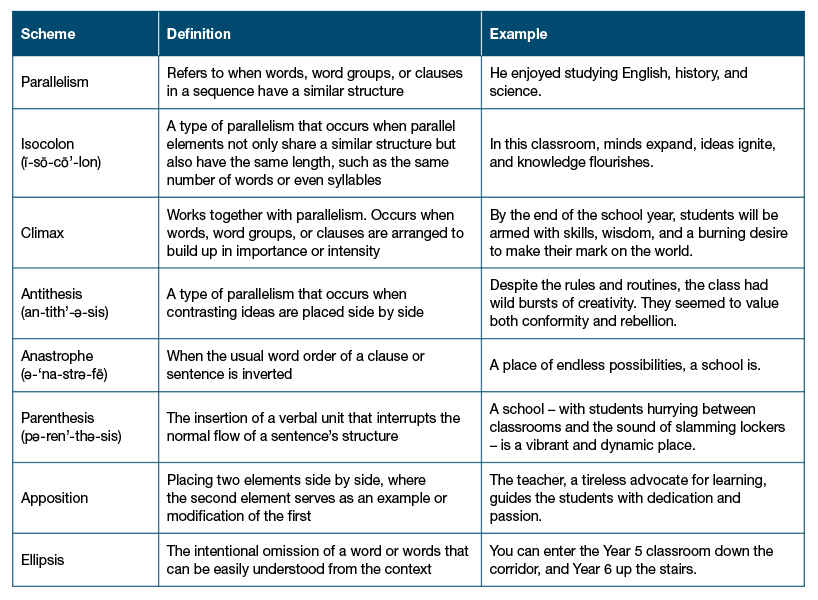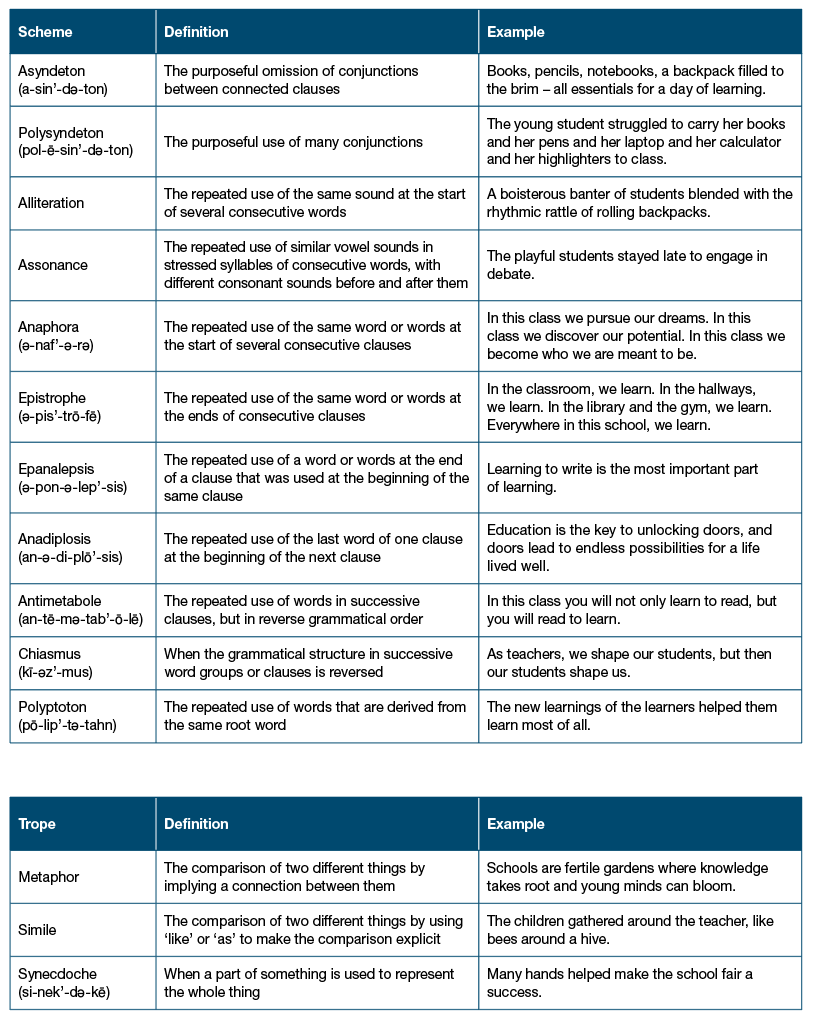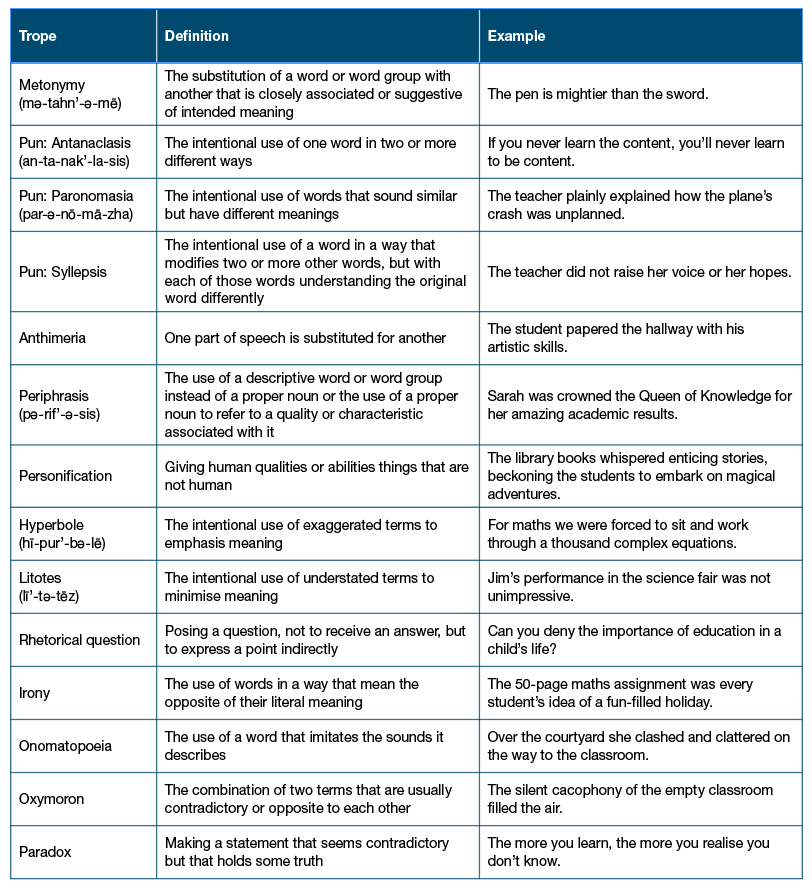
Figuring out figurative language in high-scoring narratives
Recently, I started a new research project with four colleagues to investigate the writing choices made by primary and secondary school students who scored highest of all Queensland students on the three most recent NAPLAN writing tests. I have done this sort of research in the past but always focused on successful persuasive writing across the tested year levels (i.e., Years 3, 5, 7 and 9). For our new project, named NAPtime, we will investigate the narrative writing choices valued by NAPLAN markers for the first time.
By Damon Thomas
Download PDF
The Queensland Curriculum and Assessment Authority (caretakers of completed NAPLAN tests up here) granted us access to the 285 highest-scoring Queensland writing samples written for the 2019, 2021 and 2022 NAPLAN tests (i.e., roughly 20–25 samples per year level for the three years of the test). In the next couple of years, my colleagues and I will use a variety of linguistic and rhetorical frameworks to identify patterns in the students’ writing and communicate our findings to the education community.
What can we take from the emphasis on figurative language in these marking guides? It seems the designers of the NAPLAN writing test are expecting students to use figurative language in both versions, but only really sets markers up to identify the use of specific figurative devices in the persuasive version. There is possibly an assumption here that figurative language is more important in persuasive writing than in narrative writing. When you add the Australian Curriculum’s substantial but disjointed emphasis on figurative language into the mix, it’s quite likely that some Australian teachers would feel unsure about the aspects of figurative language to teach and in which genres.
My first exploration of the successful writing samples will focus on the students’ use of figurative language to entertain their readers. Figurative language choices are often referred to as figurative devices, rhetorical devices, literary devices or figures of speech, and are commonly associated with poetry and argumentation. But high-quality narratives are also overflowing with artful and playful uses of figurative language. In fact, this is often what makes the stories we read so engaging.
Figurative language has been the focus of research and teaching for (literally) thousands of years. The figurative language choices I’ll be looking for in the NAPLAN writing samples were identified first by Aristotle and other rhetoricians way back in Ancient Greece. Aristotle outlined the ins and outs of five canons of classical rhetoric – Invention, Arrangement, Style, Memory, and Delivery – which included everything a speaker or writer would need to discover, organise and communicate compelling ideas through spoken and written texts. Of most relevance to our NAPtime research project is the third canon, Style, which concerns how we put the ideas we have into words that are communicated with others. This is the part of classical rhetoric that dealt with figurative language.
Figurative language in the Australian Curriculum: English
It’s quite amazing to see just how much emphasis is given to figurative language in the Australian Curriculum: English. Even a cursory glance will show this is one of the most underrated aspects of English teaching. Unlike certain other aspects of English that are only dealt with in niche sub-strands of the curriculum, figurative language can be found across all three strands (i.e., Language, Literature and Literacy), spread out across a full eight sub-strands!
While figurative language is taught from Year 1 to Year 10, it becomes especially prominent in the secondary school years, where it is mentioned directly in six content descriptions for each secondary year level (i.e., 7, 8, 9 and 10). In this sense, teaching students to interpret and use figurative language is likely a regular part of every secondary English teacher’s day job.
Despite the wide reach of figurative language, this aspect of English is, arguably, treated in a fairly disjointed manner in the Australian Curriculum:
English. Figurative language pops up here, there and everywhere. It is described as serving many varied functions in different types of texts, such as enhancing and building up layers of meaning; shaping how readers interpret and react to texts; influencing audience emotions, opinions, and preferences; evaluating phenomena; and conveying information and ideas. At times, it is described as a stylistic tool of poetry, songs and chants; at other times it’s a persuasive tool of argumentation; and at other times it’s a literary tool of storytelling.
All these uses make figurative language feel a bit like sand slipping through your fingers; nothing really ties it together.
The Australian Curriculum: English refers to 14 figurative devices explicitly (i.e., metaphor, simile, personification, onomatopoeia, assonance, alliteration, hyperbole, idiom, allegory, metonymy, ellipses, puns, rhetorical questions and irony).
This might seem like a lot, but more than 200 figurative devices have been identified in the writing of William Shakespeare alone (Joseph, 1947)! It would be interesting to know how and why these 14 figurative devices have been named in the curriculum.
Figurative language in the NAPLAN writing tests
Another place educators come across figurative devices is in the NAPLAN writing marking guides. The persuasive writing version of the test includes a criterion named Persuasive devices, which involves “The use of a range of persuasive devices to enhance the writer’s position and persuade the reader” (ACARA, 2013, p. 6).
In the glossary of the persuasive writing marking guide, nine figurative devices are mentioned: alliteration, simile, metaphor, personification, idiom, puns, irony, hyperbole, and rhetorical questions. The guide also includes some descriptions of the effects of other figurative devices (e.g., parallelism, anaphora, epistrophe) without mentioning the technical names (e.g., “Words or phrases at the beginning or end of successive clauses or statements” (ACARA, 2013, p. 87) refers to anaphora and epistrophe).
The NAPLAN narrative writing marking guide (ACARA, 2010) drops the Persuasive devices criterion and replaces it with another named Character and setting, which involves “The portrayal and development of character” and “The development of a sense of place, time and atmosphere” (p. 4). Only metaphor and simile are mentioned in the glossary as part of key vocabulary choices, while ellipsis is mentioned as a key resource for building text cohesion.
What can we take from the emphasis on figurative language in these marking guides? It seems the designers of the NAPLAN writing test are expecting students to use figurative language in both versions, but only really sets markers up to identify the use of specific figurative devices in the persuasive version. There is possibly an assumption here that figurative language is more important in persuasive writing than in narrative writing. When you add the Australian
Curriculum’s substantial but disjointed emphasis on figurative language into the mix, it’s quite likely that some Australian teachers would feel unsure about the aspects of figurative language to teach and in which genres.
Our approach in the NAPtime research
Educators and curriculum designers in contemporary settings might get a better grip on figurative devices if we follow the lead of classical rhetoricians who divided them into two categories: schemes and tropes. Both can be described as fundamental to how we put together sentences in written or spoken texts.
Simply put, a scheme (from the Greek word schēma, meaning form or shape) involves changing the usual pattern or arrangement of words in a sentence. A well-known scheme is alliteration, which involves the repetition of initial phonemes in two or more adjacent words, such as when Professor McGonagall from Harry Potter described students as “behaving like a babbling, bumbling band of baboons!”
A trope (from the Greek word tropein, meaning to turn) involves changing the normal meaning of words in a sentence. A well-known trope is metaphor, which involves making a comparison between two different things that have something in common, such as when Mrs Dursley from Harry Potter is compared to a crane (i.e., a longnecked bird): “she spent so much of her time craning over garden fences, spying on the neighbours.”
Dividing the 14 figurative devices mentioned in the Australian Curriculum: English and the nine in the NAPLAN persuasive writing marking guide into schemes and tropes shows that these documents strongly favour tropes (i.e., nine tropes vs. three schemes in the curriculum and eight tropes vs. one scheme in the NAPLAN marking guide).
A key interest of my research into high-scoring NAPLAN narratives will be to determine how the students used schemes and tropes to entertain their readers, and how well these key policy documents reflect the choices valued in the NAPLAN writing context.
I will pay close attention to the following 19 schemes and 17 tropes that are particularly useful in contemporary writing (Corbett & Connors, 1999).
Clearly, this is more than double the number mentioned in the curriculum and NAPLAN, and some may not have been used much or at all by the high- scoring students. It’s also possible that some devices were only used in certain year levels, so there is potential for interesting findings here. If we discover that NAPLAN markers rewarded students for using figurative devices that do not even appear in the key policy documents guiding our teachers, there will be fascinating implications for the usefulness, equity and ongoing enhancement of these documents.
Without further ado, here is a table of the schemes and tropes that I will look for in my first NAPtime article, with pronunciations, definitions and examples:



I look forward to letting you know what we find. My hypothesis is that figurative language plays a much larger role in high-scoring narratives than the narrative marking guide suggests.
This article appeared in the Sept 2023 edition of Nomanis.